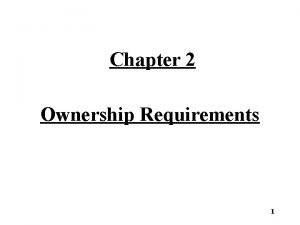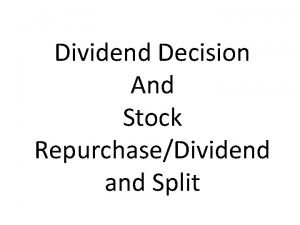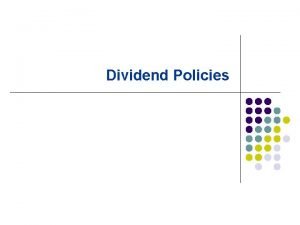Revise Lecture 18 Ownership ratios Dividend ratios The
















- Slides: 16

Revise Lecture 18

Ownership ratios Dividend ratios The common shareholder is very concerned about the position taken by the firm with respect to the payment of cash dividends. If the firm is paying insufficient dividends, the share is not attractive to investors desiring some current income from their investment. If it pays excessive dividends, it may not be retaining adequate funds to finance future growth

Ownership ratios Dividend ratio To pay consistent and adequate dividends, the firm must be liquid and profitable. Without liquidity, the firm cannot locate the cash needed to pay dividends. Without profits, the firm does not have sufficient retained earnings to make dividend declaration.

Ownership ratios Dividend ratio Two dividend ratios are particularly important; 1) Dividend payout ratio; Formula = DPS / EPS It tells us % of the firm’s earnings is being paid to the common shareholders in the form of dividends.

Ownership ratios Dividend ratio 2) Dividend yield ratio Formula = DPS / Market price per share It gives the current return to the investor as a % of his or her investment. It is of interest to potential shareholders who are considering purchasing the firm’s stock and who desire dividends as a source of income

Analyzing Ownership Ratios P 121

Profit Planning • A major role of the financial manager lies in setting corporate goals and the policies to achieve them. • Planning is the specific process of setting goals and developing ways to reach them. Planning represents the firm’s efforts to predict events and be prepared to deal with them.

Profit Planning • In many firms the task of planning is coordinated by a department of one or more persons designated as the corporate planning department, long-range planning department or budgeting department. • Whatever the title these individuals are responsible for receiving inputs from sales, production, finance and other operating areas of the company.

Profit Planning Process The firm’s formal planning process involves the efforts of many operating and financial managers. The final plans, whether short or long-term become the blueprint for the firm’s operations.

Profit Planning • Planning basically involves two major areas for analysis: 1. External Factors 2. Internal Factors

Profit Planning • • External Factors The planner evaluates the outlook for the economy as a whole. Will the firm be operating during a period of economic growth and expansion? Will the next one to three years be a period of recession and stagnation? Is the industry anticipating growth or decline?

Profit Planning External Factors • Does the firm have stable market for its products? • Is the firm’s competition gaining or losing strength?

Profit Planning Internal Factors Some factors are internal in the sense that they are under the control of the firm. Foe example, such items as cash levels, kind amount of inventories.

Profit Planning Controllable Internal factors Market demand for the product line or services. The firm can decide, after a careful evaluation of the external factors, what mix of products or services it will offer in the marketplace. If the firm produces its existing products line, what sales are likely? If it changes or modifies its products, will sales increases or decrease?

Profit Planning • Future Costs. A firm may have a number of opportunities to reduce the costs of its products in future periods. The purchase of a new and more modern equipment may increase fixed costs while reducing variable costs. Should the equipment be purchased? Better scheduling or planning may help minimize production or administrative expenses.

Profit Planning • Sources of funds. As the firm plans expenditures, it analyzes the funds available to finance its activities. If sufficient funds are not predicted, steps are taken to locate money as needed at reasonable costs. • These factors are internal only in the sense that the firm has the ability to influence them to a greater or lesser degree.
 01:640:244 lecture notes - lecture 15: plat, idah, farad
01:640:244 lecture notes - lecture 15: plat, idah, farad How to revise for english literature gcse
How to revise for english literature gcse Revise well
Revise well How long should i revise for
How long should i revise for Zero discrimination power
Zero discrimination power Revise present continuous tense
Revise present continuous tense Lets revise
Lets revise Tentative goal statement
Tentative goal statement What is revision
What is revision Revise and resubmit letter example
Revise and resubmit letter example Revise picture
Revise picture I dont know how to revise
I dont know how to revise Kuesioner terstruktur dan tidak terstruktur
Kuesioner terstruktur dan tidak terstruktur Response
Response I will revise
I will revise Judith murciano
Judith murciano Lets revise
Lets revise































